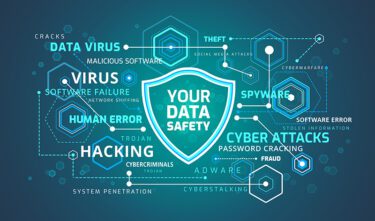The point-of-sale (POS) system is critical in any retail business, serving as the key interaction point between employees and customers. Ensuring it functions correctly is essential. However, even if the hardware is operational, outdated technology can jeopardize sensitive customer data, posing significant security risks.
Understandably, business owners may hesitate to replace functioning hardware due to the expense. However, the cost of new equipment is minor compared to the potential financial impact of cybersecurity breaches and the loss of customer trust. According to industry standards, hardware should be replaced every three to five years to ensure optimal security and performance.
Industry standards state hardware should be replaced every 3 to 5 years.
What can happen to outdated retail POS systems?
 These days’ point-of-sale terminals do much more than take payments and process orders; they can also keep track of inventory and communicate with other terminals or locations. They are valuable pieces of technology that are the cornerstone of brick-and-mortar businesses.
These days’ point-of-sale terminals do much more than take payments and process orders; they can also keep track of inventory and communicate with other terminals or locations. They are valuable pieces of technology that are the cornerstone of brick-and-mortar businesses.
However, several data breaches and security difficulties at POS systems in the last few years suggest that these systems are susceptible to assaults.
Keeping yourself well-informed and taking preventive measures to secure your retail establishment is essential for avoiding a hack. In this article, we’ll discuss cybersecurity risks, compliance issues, and poor customer service that can occur due to outdated hardware and offer some solutions.
Cybersecurity Risks
Many security risks can come from aging hardware. Due to incompatibilities, you cannot take advantage of security updates and other measures software vendors take to fix vulnerabilities in their products if you are using an older technology. Since not all users will install the newest security updates, hackers often target older software with known flaws.
“There were 2,365 cyberattacks in 2023 with 343,338,964 victims. 2023 saw a 72% increase in data breaches since 2021, which held the previous all-time record.”According to the Identity Theft Resource Center.
 Starting in 2016, the number of cyber assaults worldwide will climb by 125% by 2021, and this trend will continue in 2022, posing an ever-greater risk to organizations and people. Malware assaults in 2020 were 358 percent higher than in 2019. Cybercriminals target weaknesses in businesses’ security and use phishing emails to trick people into releasing sensitive information. While phishing victims typically lose about $150 to these attacks, data breaches cost over $12,000 on average.
Starting in 2016, the number of cyber assaults worldwide will climb by 125% by 2021, and this trend will continue in 2022, posing an ever-greater risk to organizations and people. Malware assaults in 2020 were 358 percent higher than in 2019. Cybercriminals target weaknesses in businesses’ security and use phishing emails to trick people into releasing sensitive information. While phishing victims typically lose about $150 to these attacks, data breaches cost over $12,000 on average.
Criminals employ point-of-sale software to steal financial data, such as credit card numbers. They then use those accounts to make fraudulent transactions that cost the victims money and damage their credit.
Since merchants, who are the primary clients of point-of-sale vendors, may be severely impacted by fraud, preventing it is crucial to the survival of point-of-sale sellers.
Compliance Issues
Outdated hardware increases security risks, especially for businesses that must adhere to regulations such as GDPR, HIPAA, PCI, SOX, and others. Your hardware must be current and actively maintained to meet these requirements. You should expect to pay more fines if you are a breach victim. If your hardware has reached end-of-life (EOL), you may be fined even more money if you are audited and found to be in violation. Even if your small company doesn’t face additional regulatory compliances, staying ahead of the curve requires replacing your old gear in preparation for future data compliance rules like CPA in the United States.
There are also regulations stemming from the Payment Card Industry Security Standards Council, which eventually developed the Payment Card Industry Data Security Standards. While the PCI standards are not government-regulated, businesses that handle credit cards may face penalties from their bank if they are discovered non-compliant with the rules.
Historically, retailers have had exclusive responsibility for conducting annual compliance audits. Stores must assess their layout, network infrastructure, POS hardware, and POS software. This is a significant ongoing investment of time and money for stores to plan.
By combining the strength of NCR Counterpoint with the dependability of the RCS Cloud Services, RCS and NCR help retailers meet their compliance needs with less effort. By evaluating NCR and RCS, they ensure these benchmarks are met or surpassed each year. Consequently, the merchant may rest easy knowing the compliance review will take around 66% less time than usual.
Poor Customer Service
 Whether your retail business is a restaurant, gas station, retail store, or another industry, a POS system that’s down for the count is something you want to avoid. Your customers depend on you to take their payment, whether cash, credit, gift cards, or a digital payment with a smartphone or watch. You lose sales and customers when your system goes down for minutes or a few hours. You frustrate your clients and employees. Frequent disruptions invite clients to hop online and leave bad reviews, warning others from your business.
Whether your retail business is a restaurant, gas station, retail store, or another industry, a POS system that’s down for the count is something you want to avoid. Your customers depend on you to take their payment, whether cash, credit, gift cards, or a digital payment with a smartphone or watch. You lose sales and customers when your system goes down for minutes or a few hours. You frustrate your clients and employees. Frequent disruptions invite clients to hop online and leave bad reviews, warning others from your business.
Data breaches are even worse for businesses. The most typical POS issue is a result of an unprotected network. These vulnerable setups are an open invitation for hackers to steal sensitive information like credit card numbers and firm financials. Your point-of-sale equipment should be maintained on a separate, encrypted network if feasible. Passwords should be changed at least once every 90 days to prevent breaches of sensitive information.
Updating your program to the latest version is also essential. Companies constantly update and patch their operating systems with new features and fixes. Updated software provides you with the most recent safeguards, allowing you to rest easy.
Device Management
Even if the network is secure, your devices still need to be safeguarded. Passwords are a crucial first step in this process. Instruct your staff to log out of the POS system every time they leave the terminal and never reveal any sensitive information to anybody. Choose technological items that already have built-in safety features.
The security of POS systems may also be improved in other straightforward ways. For instance, two-factor authentication on these devices is an easy step many overlook. Two-factor authentication (2FA) is a security system that requires two separate, distinct forms of identification to access something.
When you first link the device to your computer, you should immediately change the factory-issued passwords. There are counterfeit POS devices on the market that might offer hackers access to your sensitive customer information. Therefore, it’s important you only buy from trusted vendors.
Merchants are concerned not only with the safety of their financial and customer information but also with the uninterrupted operation of their point-of-sale systems in the face of cyber assaults or technological difficulties.
Retailers are keen on protecting their POS systems from intrusion and keeping customers’ financial data safe. To do this, good POS software should provide robust POS security technologies and trustworthy security monitoring and incident response capabilities.
The security monitoring and incident response service should monitor POS application-related activity, identify and flag risks, give real-time solutions to any concerns, and inform internal or external IT professionals when a breach happens.
Providers of point-of-sale systems, which handle massive amounts of data transactions daily, may reassure their retail clients using a tried and true POS security monitoring and incident response solution.
Cybercrime is on the rise and becoming more complex and dangerous every year. This is a frustrating issue that all businesses eventually deal with. Your POS system and data will be much safer if you take precautions and care.
Who has to pay for breaches?
The consequences of a data breach in retail extend beyond the money that might be lost or stolen.
Some other expenses businesses may have to pay:
-
- Reimbursing clients monetarily and keeping tabs on their identities
- In the case of a class action lawsuit, litigation
- Fixing the breach and preventing further damage
- In the retail industry, a drop in customer trust may have a devastating effect on a business’s reputation and bottom line
The analysis estimates that by 2022, discovery and escalation will account for $1.44 million of the total cost of data breaches, an increase of $1.40 million, or 16.1%, from 2021’s $1.24 million. These include the expenses incurred by a business to discover a breach. The expenses include forensic and investigative work, assessment and audit services, crisis management, and executive and board communications.
What Other Hazards Does Outdated Equipment Pose To My Business?
Finding replacement components for EOL equipment is like trying to get an alternator for a 1985 Mustang: it’s difficult and expensive. Many businesses purchase secondhand components without proper due diligence, which may lead to higher maintenance costs and unreliability. Incompatibilities between hardware and software caused by outdated hardware need remediation, slowing workflow and reducing productivity.
Businesses that use antiquated gear risk falling behind the pack. Then, the competition may move in swiftly and take over the market. Updating your software and apps is crucial to maintaining agility and preventing breaches in your information technology infrastructure. Remember that a security breach or falling far behind the competition may devastate your brand.
Finally, out-of-date hardware may not meet the requirements of industry rules like HIPAA, SOX, PCI, or GDPR. In commercial establishments, all of these things need modern, properly supported software. Think of the potential fines you’d have to pay if your systems were compromised and not up to code; even more stringent U.S. compliance rules may be on the horizon.
When assaults occur, small businesses may easily be swamped by the combined efforts of hackers and other issues relating to old gear. The technical experts at RCS can upgrade all your systems and provide the maintenance and support you need to counteract such threats and maintain the optimal performance of your business’s IT infrastructure.
Contact us now for a no-cost assessment of how to carry your infrastructure into 2025 and beyond!



